Parameters
Entity
The Entity parameter allows you to select the part of your organisation whose calls the report should include, e.g. a site, a group or an individual user.
Selecting an entity
To select an entity, click on the button alongside the
Entity label:
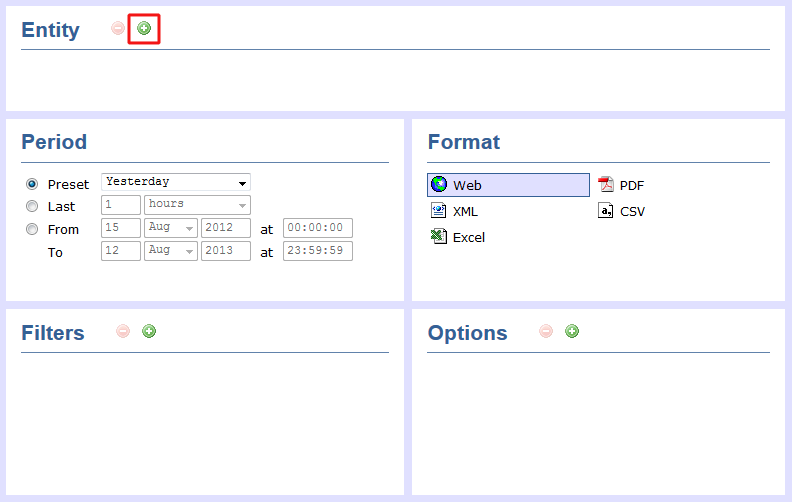
A new window will open, allowing you to navigate through the Directory in order to locate the entity you want to report on:
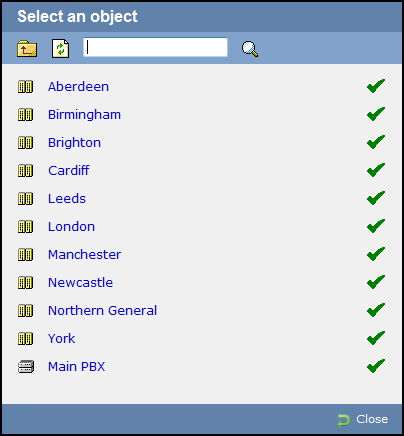
info
If your web account is restricted to a specific part of the Directory, only those entities which you are allowed to access will show in this window.
To drill down into the directory structure, click on a hyperlink.
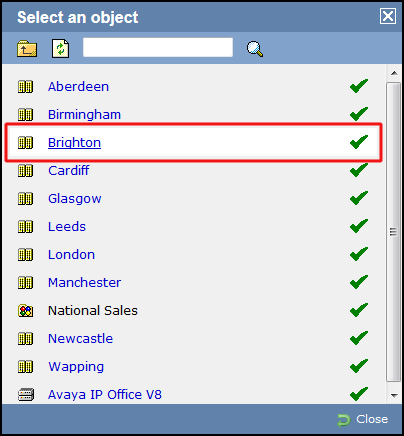
To go up in the hierarchy of the directory, click on the button.
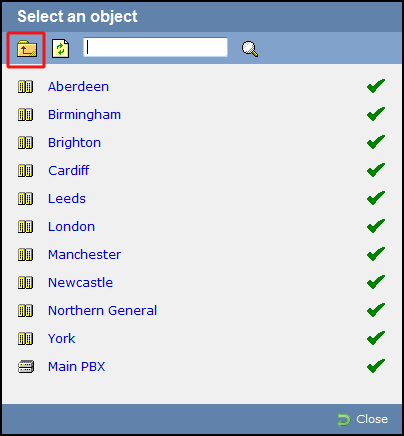
To search for a specific entity, e.g. site, group or user, enter its name in the search bar at the top of the window and click on the icon.
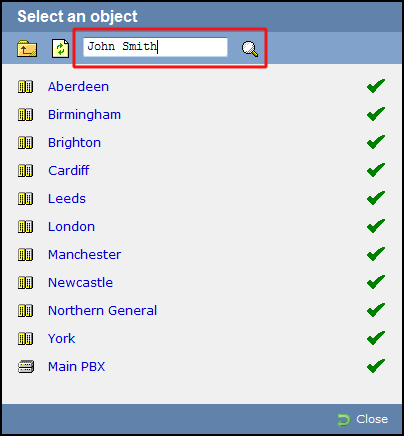
To select an entity, click on the icon alongside it.
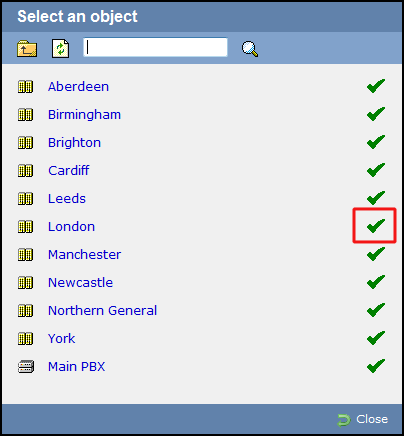
The name and directory path of the selected entity will be added in the Entity field, as shown below:

Deleting an entity
To delete an entity, select it from the Entity field and click on the button, as shown below:
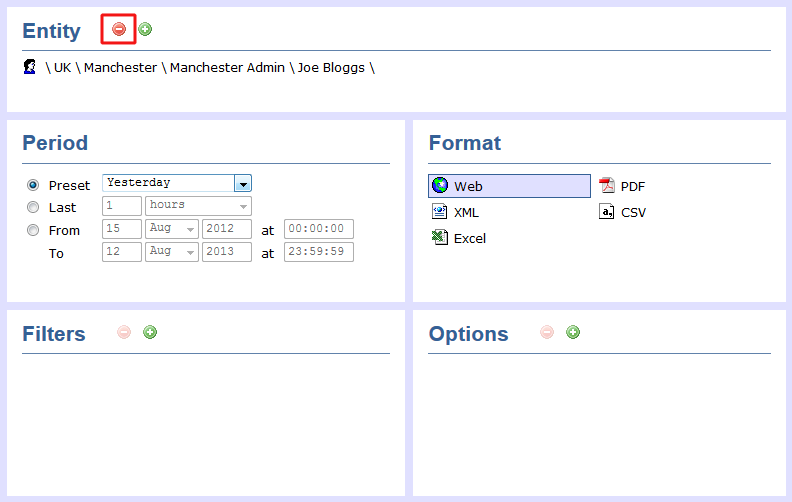
Period
The Period parameter allows you to specify the "reporting period", which is a time span that covers the calls you want the report to include.
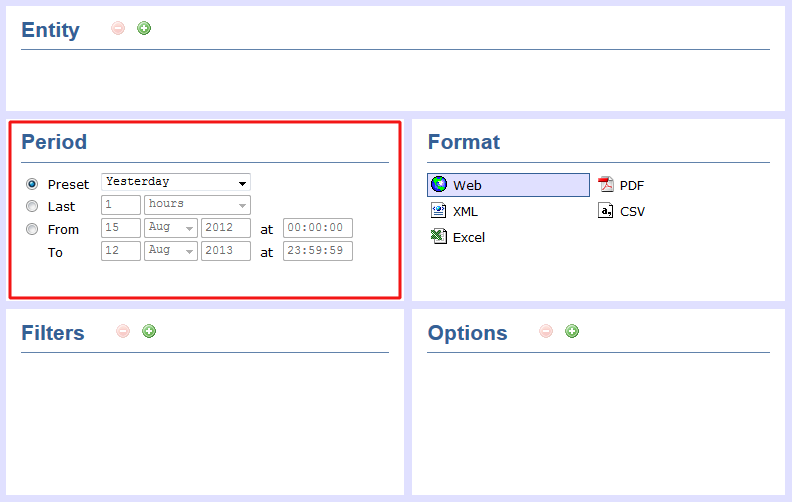
Preset period
The Preset option contains several reporting periods available for selection, based on the standard Gregorian calendar. The table below describes how the start and end times are defined for each preset period:
| Period | Description |
|---|---|
| Today | The start and end dates are set to the current date. The start time is set to 00:00:00 and the end time to 23:59:59. |
| Yesterday | The start and end dates are set to the current date minus one day. The start time is set to 00:00:00 and the end time to 23:59:59. |
| This week | The start date is set to the first day of the current week (normally Monday). The end date is set to the current day. The start time is set to 00:00:00 and the end time to the current time. |
| Last week | The start date is set to the date of the last Monday, and the end date is set to the start date plus seven days. The start time is set to 00:00:00 and the end time to 23:59:59. |
| This month | The start date is set to the first day of the current month. The end date is set to the current day. The start time is set to 00:00:00 and the end time to the current time. |
| Last month | The start date for this period is set in three stages: The day is set to the first day of the month. The month is set to the previous month. The year is set to the current year, unless it is currently January, in which case, the previous year is used. The start and end times are set to 00:00:00 and 23:59:59 respectively. |
| This year | The start date is set to the first day of the first month of the current year, whilst the end date is set to today's date. The start and end times are set to 00:00:00 and 23:59:59 respectively. |
| All calls | The start and end dates and times are set to the dates and times of the first and last call in the entire call database, respectively. |
Last period
The Last period option is an alternative to the preset periods described above, allowing you to choose the number of minutes, days, months etc. you want to run the report for.
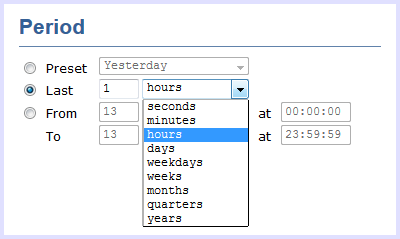
info
The start and end times are defined as for the Preset periods described above. For example, Last week is defined as Monday to Sunday of the previous week, while Last 7 days is the preceding 7 days from the current day.
Custom period
In addition to the presets described above, it is possible to specify a custom reporting period by choosing Custom period from the Period drop-down list and specifying your own Start date, Start time, End date and End time of the period you want to report on.
Filters
The Filter parameter allows you to add one or more filters to your report in order to narrow down your search results. Each filter consists of two elements: a text box where you can enter the filtering value and a drop-down list containing the criteria by which this value should be matched in the results.
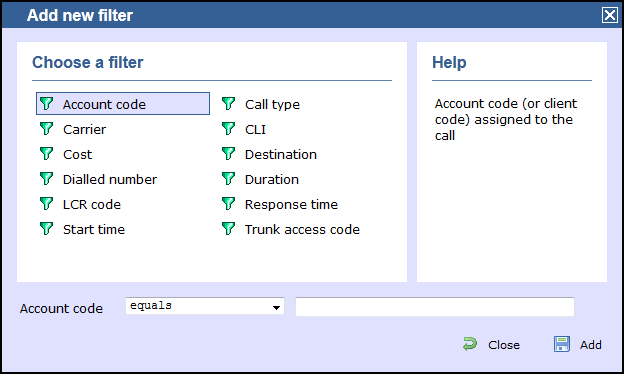
A list describing all filters available in TIM Enterprise is presented below; however, note that not all filters are relevant to all reports. To jump to a specific section please select it by clicking on the section you want to jump to on the right-hand side.
Account code
To filter a report by account code, enter the relevant value in the box provided and select the criteria by which you want this to be matched in the results. The options contained in the drop-down list are described in the table below:
| Criteria | Description | Example | Example results |
|---|---|---|---|
| equals | Search for calls whose account code matches a particular value. | Account Code equals 1140 | Show only calls whose account code is 1140. |
| is not equal to | Exclude calls whose account code matches a particular value. | Account Code is not equal to 1140 | Exclude calls whose account code is 1140. |
| begins with | Search for calls whose account code begins with a particular combination of digits. | Account code begins with 11 | Show only calls whose account code begins with 11. |
| does not begin with | Exclude calls whose account code begins with a particular combination of digits. | Account code does not begin with 11 | Exclude calls whose account code begins with 11. |
| ends with | Search for calls whose account code ends with a particular combination of digits. | Account code ends with 40 | Show only calls whose account code ends with 40. |
| does not end with | Exclude calls whose account code ends with a particular combination of digits. | Account code does not end with 40 | Exclude calls whose account code ends with 40. |
| contains | Search for calls whose account code contains a particular combination of digits. | Account code contains 14 | Show only calls whose account code contains 14. |
| does not contain | Exclude calls whose account code contains a particular combination of digits. | Account code does not contain 14 | Exclude calls whose account code contains 14. |
Carrier
The carrier is the tariff table used to cost calls. If you use more than one carrier, you can choose to filter your results by displaying or excluding calls routed over a particular carrier.
| Criteria | Description | Example | Example results |
|---|---|---|---|
| equals | Search for calls that were routed over a particular carrier. | Carrier equals BT | Show only calls routed over BT carrier. |
| is not equal to | Exclude calls that were routed over a particular carrier. | Carrier is not equal to BT | Exclude calls routed over BT carrier. |
Cost
You can define a cost filter to include calls above or below specific values by entering your criteria, as shown below:
| Criteria | Description | Example | Example results |
|---|---|---|---|
| is greater than | Search for calls whose cost is greater than a particular value. | Cost is greater than 5.00 | Show only calls whose cost is greater than 5.00 |
| is less than | Search for calls whose cost is less than a particular value. | Cost is less than 15.00 | Show only calls whose cost is less than 15.00. |
| equals | Search for calls whose cost is equal to a particular value. | Cost equals 7.00 | Show only calls whose cost is exactly 7.00. |
| is not equal to | Exclude calls whose cost is equal to a particular value. | Cost in not equal to 1.00 | Exclude calls whose cost is exactly 1.00. |
Dialled number
To filter a report by dialled number, enter the relevant value in the box provided and select the criteria by which you want this to be matched in the results. The options contained in the drop-down list are described in the table below:
| Criteria | Description | Example | Example results |
|---|---|---|---|
| equals | Search for calls whose dialled number matches a particular value. | Dialled number equals 02072652600 | Show only calls whose dialled number is 02072652600. |
| is not equal to | Exclude calls whose dialled number matches a particular value. | Dialled number is not equal to 02072652600 | Exclude calls whose dialled number is 02072652600. |
| begins with | Search for calls whose dialled number begins with a particular combination of digits. | Dialled number begins with 00 | Show only calls whose dialled number begins with 00. |
| does not begin with | Exclude calls whose dialled number begins with a particular combination of digits. | Dialled number does not begin with 00 | Exclude calls whose dialled number begins with 00. |
| ends with | Search for calls whose dialled number ends with a particular combination of digits. | Dialled number ends with 2600 | Show only calls whose dialled number ends with 2600. |
| does not end with | Exclude calls whose dialled number ends with a particular combination of digits. | Dialled number does not end with 2600 | Exclude calls whose dialled number ends with 2600. |
| contains | Search for calls whose dialled number contains a particular combination of digits. | Dialled number contains 265 | Show only calls whose dialled number contains 265. |
| does not contain | Exclude calls whose dialled number contains a particular combination of digits. | Dialled number does not contain 265 | Exclude calls whose dialled number contains 265. |
LCR code
To filter your results by Least Cost Routing (LCR) code, enter it in the box provided and select the criteria by which you want this to be matched in the results. The options contained in the drop-down list are described in the table below:
| Criteria | Description | Example | Example results |
|---|---|---|---|
| equals | Search for calls whose LCR code matches a particular value. | LCR code equals 1470 | Show only calls whose LCR code is 1470. |
| is not equal to | Exclude calls whose LCR code matches a particular value. | LCR code is not equal to 1470 | Exclude calls whose LCR code is 1470. |
| begins with | Search for calls whose LCR code begins with a particular combination of digits. | LCR code begins with 14 | Show only calls whose LCR code begins with 14. |
| does not begin with | Exclude calls whose LCR code begins with a particular combination of digits. | LCR code does not begin with 14 | Exclude calls whose LCR code begins with 14. |
| ends with | Search for calls whose LCR code ends with a particular combination of digits. | LCR code ends with 70 | Show only calls whose LCR code ends with 70. |
| does not end with | Exclude calls whose LCR code ends with a particular combination of digits. | LCR code does not end with 70 | Exclude calls whose LCR code ends with 70. |
| contains | Search for calls whose LCR code contains a particular combination of digits. | LCR code contains 47 | Show only calls whose LCR code contains 47. |
| does not contain | Exclude calls whose LCR code contains a particular combination of digits. | LCR code does not contain 47 | Exclude calls whose LCR code contains 47. |
Start time
This option allows you to filter calls based on the time the call started. Specify the start time in the text box provided using the hh:mm:ss format and choose from the drop-down list the criteria by which you want this to be matched in the reports.
| Criteria | Description | Example | Example results |
|---|---|---|---|
| is greater than | Search for calls that started after a particular time of day | Start time is greater than 10:00:00 | Show only calls that began after 10 AM |
| is less than | Search for calls that started before a particular time of day. | Start time is less than 10:00:00 | Show only calls that began before 10 AM. |
| equals | Search for calls that started at an exact time of day. | Start time equals 10:30:00 | Show only calls that started at exactly half-past 10 AM. |
| is not equal to | Exclude calls that started at an exact time of day. | Start time not equal to 10:30:00 | Exclude calls which started at exactly half-past 10 AM. |
Call type
The Call type parameter allows you to search for specific types of call, from the following list:
All inbound
Inbound answered
Inbound DDI only
Inbound transfer only
Inbound missed call
All outbound calls
Outbound connected only
Outbound not connected only
Outbound operator assisted
Tandem
User mobile calls
User SMS
All internal
Internal answered only
Internal not answered only
Internal not connected
Private wire
Feature
You can choose the report to include only calls of a particular type, or call types other than the one you select, as per the table below:
Criteria Description Example Example results equals Search for calls of a particular type. Call type equals All internalShow only internal calls. is not equal to Exclude calls of a particular type. Call type is not equal to All internalShow all call types, except for internal calls.
info
To report on all types of call, leave the default selection as (All call types).
CLI
Calling Line Identification (CLI) is the telephone number of the remote caller in an incoming call scenario. To filter a report by CLI, enter the relevant value in the box provided and select the criteria by which you want this to be matched in the results. The options contained in the drop-down list are described in the table below:
| Criteria | Description | Example | Example results |
|---|---|---|---|
| equals | Search for calls whose CLI matches a particular value. | CLI equals 02072652600 | Show only calls whose CLI is 02072652600. |
| is not equal to | Exclude calls whose CLI matches a particular value. | CLI is not equal to 02072652600 | Exclude calls whose CLI is 02072652600. |
| begins with | Search for calls whose CLI begins with a particular combination of digits. | CLI begins with 0789 | Show only calls whose CLI begins with 0789. |
| does not begin with | Exclude calls whose CLI begins with a particular combination of digits. | CLI does not begin with 0789 | Exclude calls whose CLI begins with 0789. |
| ends with | Search for calls whose CLI ends with a particular combination of digits. | CLI ends with 2600 | Show only calls whose CLI ends with 2600. |
| does not end with | Exclude calls whose CLI ends with a particular combination of digits. | CLI does not end with 2600 | Exclude calls whose CLI ends with 2600. |
| contains | Search for calls whose CLI contains a particular combination of digits. | CLI contains 265 | Show only calls whose CLI contains 265. |
| does not contain | Exclude calls whose CLI contains a particular combination of digits. | CLI does not contain 265 | Exclude calls whose CLI contains 265. |
Destination
If you want to filter calls to a specific, known destination, type the name of the destination in the text box provided and select the criteria by which you want this to be matched in the results. The options contained in the drop-down list are described in the table below:
| Criteria | Description | Example | Example results |
|---|---|---|---|
| equals | Search for calls whose destination matches a particular value. | Destination equals Warren Smith | Show only calls whose destination is Warren Smith. |
| is not equal to | Exclude calls whose destination matches a particular value. | Destination is not equal to Warren Smith | Exclude calls whose destination is Warren Smith. |
| begins with | Search for calls whose destination begins with a particular combination of digits. | Destination begins with Warren S | Show only calls whose destination begins with Warren S. |
| does not begin with | Exclude calls whose destination begins with a particular combination of digits. | Destination does not begin with WarrenS | Exclude calls whose destination begins with Warren S. |
| ends with | Search for calls whose destination ends with a particular combination of digits. | Destination ends with Smith | Show only calls whose destination ends with Smith. |
| does not end with | Exclude calls whose destination ends with a particular combination of digits. | Destination does not end with Smith | Exclude calls whose destination ends with Smith. |
| contains | Search for calls whose destination contains a particular combination of digits. | Destination contains Warren | Show only calls whose destination contains Warren. |
| does not contain | Exclude calls whose destination contains a particular combination of digits. | Destination does not contain Warren | Exclude calls whose destination contains Warren. |
Duration
To filter calls above or below a particular duration, enter the duration (in seconds) in the text box provided and select the criteria by which you want this to be matched in the results. The options contained in the drop-down list are described in the table below:
| Criteria | Description | Example | Example results |
|---|---|---|---|
| is greater than | Search for calls whose duration is longer than a particular value | Duration is greater than 30 | Show only calls whose duration is longer than 30 seconds |
| is less than | Search for calls whose duration is shorter than a particular value. | Duration is less than 60 | Show only calls whose duration is shorter than 60 seconds |
| equals | Search for calls whose duration is exactly equal to a particular value. | Duration equals 10 | Show only calls whose duration is exactly 10 seconds |
| is not equal to | Exclude calls whose duration is not equal to a particular value. | Duration not equal to 10 | Exclude calls whose duration is exactly 10 seconds |
Response time
This option allows you to filter calls based on their response time, measured in seconds. Specify the desired response time threshold in the text box provided and select the criteria by which you want this to be matched in the results. The options contained in the drop-down list are described in the table below:
| Criteria | Description | Example | Example results |
|---|---|---|---|
| is greater than | Search for calls whose response time is longer than a particular value | Response time is greater than 10 | Show only calls whose response time is longer than 10 seconds |
| is less than | Search for calls whose response time is shorter than a particular value. | Response time is less than 10 | Show only calls whose response time is shorter than 10 seconds |
| equals | Search for calls whose response time is exactly equal to a particular value. | Response time equals 3 | Show only calls whose response time is exactly 3 seconds |
| is not equal to | Exclude calls whose response time is not equal to a particular value. | Response time not equal to 10 | Exclude calls whose response time is exactly 10 seconds |
Trunk access code
If your telephone system uses trunk access codes to connect calls using specific channels, you can limit your report's results to include only calls made using those codes. Specify the trunk access code in the text box provided and select the criteria by which you want this to be matched in the results. The options contained in the drop-down list are described in the table below:
| Criteria | Description | Example | Example results |
|---|---|---|---|
| equals | Search for calls whose trunk access code matches a particular value. | Trunk access code equals 12 | Show only calls whose trunk access code is 12. |
| is not equal to | Exclude calls whose trunk access code matches a particular value. | Trunk access code is not equal to 12 | Exclude calls whose trunk access code is 12. |
| begins with | Search for calls whose trunk access code begins with a particular combination of digits. | Trunk access code begins with 1 | Show only calls whose trunk access code begins with 1. |
| does not begin with | Exclude calls whose Trunk access code begins with a particular combination of digits. | Trunk access code does not begin with 1 | Exclude calls whose trunk access code begins with 1. |
| ends with | Search for calls whose trunk access code ends with a particular combination of digits. | Trunk access code ends with 2600 | Show only calls whose trunk access code ends with 2600. |
| does not end with | Exclude calls whose trunk access code ends with a particular combination of digits. | Trunk access code does not end with 2600 | Exclude calls whose trunk access code ends with 2600. |
| contains | Search for calls whose trunk access code contains a particular combination of digits. | Trunk access code contains 2 | Show only calls whose trunk access code contains 2. |
| does not contain | Exclude calls whose trunk access code contains a particular combination of digits. | Trunk access code does not contain 2 | Exclude calls whose trunk access code contains 2. |
Options
The Options parameter allows you to further narrow down your report results by excluding certain types of call or sorting the results in a particular manner.
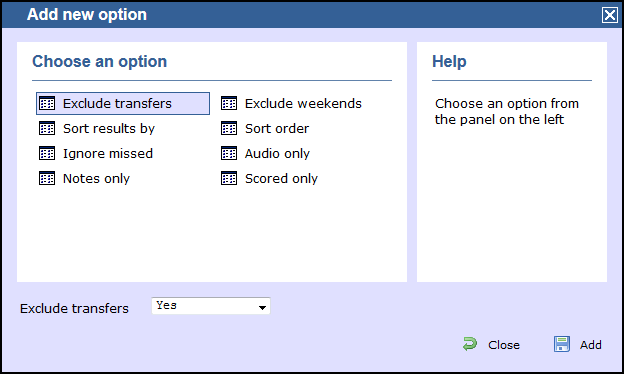
These options are specific to the type of report you are running and differ between report types. To jump to a specific section please select it by clicking on the section you want to jump to on the right-hand side.
Audio only
This option allows you to include in your results only calls that have an associated voice recording.
Callback interval
This option allows you to define, in hours, the time window in which a call must be responded to, in order to be considered handled. The default callback interval is 24 (hours), but you may enter your own value.
Call frequency
This option determines how frequently a call must have been dialled in order to feature in the results of the report. For example, to include only phone numbers that have been dialled twenty times or more, enter 20 as the minimum frequency.
Exclude weekends
To exclude weekend calls from your report's results, select the Yes option from the drop-down list.
Exclude transfers
To exclude transferred calls from your report's results, select the Yes option from the drop-down list.
Group results by
Choose from the drop-down list whether to group your results by CLI or dialled number.
Hide unused
This option allows you to exclude unused extensions from your report's results.
Hide contacts
This option allows you to hide the names associated with dialled numbers, CLIs and account codes, as defined in your web user's contacts list. To show only the phone number, select the Yes option from the drop-down list.
Hide charges
This option allows you to hide any charges applied to your report. To hide charges, select the Yes option from the drop-down list.
Ignore missed
Missed calls below a certain duration can sometimes pollute the meaning of a report's results. To exclude such short calls from your report, enter a duration threshold in the text box provided, e.g. to ignore calls below 3 seconds, enter 3.
Include internal
If you want your search results to include only calls that have notes associated with them, select the Yes option from the drop-down list.
Rank data by
Select from the drop-down list the criteria by which you want to order the report's results. The criteria are described below:
| Criteria | Description |
|---|---|
| Number of calls | Order results based on the number of calls |
| Cost | Order results based on the cost of calls |
| Dialled number | Order results based on dialled number |
| Location | Order the results based on location name |
Sort order
Choose whether you want your report's results to appear in ascending or descending order.
Sort order by
Select from the drop-down list the column by which you want to sort your report's results.
Scored only
This option allows you to include only calls that have a score associated with them, i.e. calls that have already been listened to and scored.
Summary only
To show only a summary of calls, instead of an itemised list, select the Yes option from the drop-down list.
Show legs
To show the legs of transferred calls, select the Yes option from the drop-down list. A icon will be displayed next to any call with associated call legs.
Show account codes
Select this option to display any associated account codes as an additional column in this report.
Show 'Do not log'
This option allows you to include in your results devices whose status is set to not log calls.
Show unconnected calls
To show unconnected calls in the report's results, select the Yes option from the drop-down list.
Thresholds
This option allows you to define your response target threshold(s) by entering comma-separated values in the text box provided.
For example, 5,10,15 would show response time targets for calls answered within 5, 10 and 20 seconds, respectively.
Format
This section allows you to choose the output format of your report.

The currently-available formats are as follows:-
Web
The web format is the default interface for all report types. The results are displayed in a new browser window which contains a combination of HTML, CSS and JavaScript content.
To navigate through a report consisting of multiple pages, click on the navigation buttons displayed in the top-right corner of the page.
Universally-accessible, the web format provides a mixture of graphical charts and tabular data, whose column headers are click-able to allow dynamic sorting of results.
PDF
The PDF format guarantees an identical look across all operating systems, making it an ideal format for printing out reports on paper or for e-mailing to colleagues inside and outside your organisation.
Due to the static nature of the PDF format, dynamic sorting of column headers is not available, although results can be pre-sorted using the filters and options available during report creation.
XLS
The Excel format is useful for onward manipulation of the data contained in your reports, or for including results in popular spreadsheet packages.
CSV
The CSV format allows report results to be arranged in comma-separated lists of data.
CSV files are often used for transferring data between different applications, such as databases, spreadsheets, and other third-party programs.
XML
The XML format can be useful when transferring the structured data from your report results to third-party applications, such as billing, accounting and time management applications.